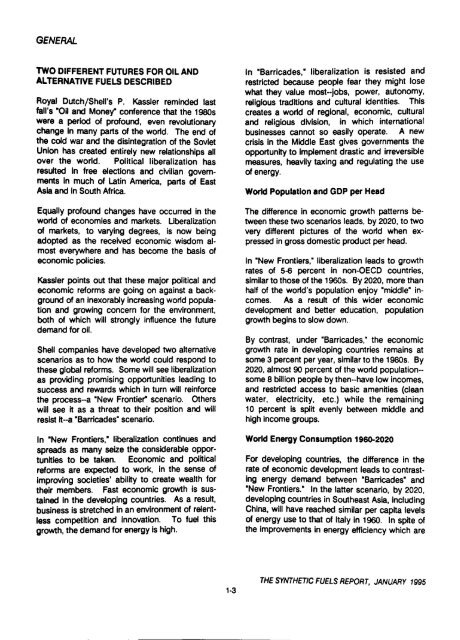Ikelic - Alliance Digital Repository
Ikelic - Alliance Digital Repository
Ikelic - Alliance Digital Repository
You also want an ePaper? Increase the reach of your titles
YUMPU automatically turns print PDFs into web optimized ePapers that Google loves.
GENERAL<br />
TWO DIFFERENT FUTURES FOR OIL AND<br />
ALTERNATIVE FUELS DESCRIBED<br />
Royal Dutch/Shell's P. Kassler reminded last<br />
fall's "Oil and Money"<br />
conference that the 1980s<br />
were a period of profound, even revolutionary<br />
change in many parts of the world. The end of<br />
the cold war and the disintegration of the Soviet<br />
Union has created entirely new relationships all<br />
over the world. Political liberalization has<br />
resulted in free elections and civilian govern<br />
ments in much of Latin America, parts of East<br />
Asia and in South Africa.<br />
Equally<br />
profound changes have occurred in the<br />
world of economies and markets. Liberalization<br />
of markets, to varying degrees, is now being<br />
adopted as the received economic wisdom al<br />
most everywhere and has become the basis of<br />
economic policies.<br />
Kassler points out that these major political and<br />
economic reforms are going on against a back<br />
ground of an inexorably increasing<br />
world popula<br />
tion and growing concern for the environment,<br />
both of which will strongly influence the future<br />
demand for oil.<br />
Shell companies have developed two alternative<br />
scenarios as to how the world could respond to<br />
these global reforms. Some will see liberalization<br />
as providing promising opportunities leading to<br />
success and rewards which in turn will reinforce<br />
the process--a "New Frontier"<br />
scenario. Others<br />
will see it as a threat to their position and will<br />
resist It a "Barricades"<br />
In "New Frontiers,"<br />
scenario.<br />
liberalization continues and<br />
spreads as many seize the considerable oppor<br />
tunities to be taken. Economic and political<br />
reforms are expected to work, in the sense of<br />
improving<br />
societies'<br />
ability<br />
to create wealth for<br />
their members. Fast economic growth is sus<br />
tained in the developing countries. As a result,<br />
business is stretched in an environment of relent<br />
less competition and innovation. To fuel this<br />
growth, the demand for energy is high.<br />
1-3<br />
In "Barricades,"<br />
liberalization is resisted and<br />
restricted because people fear they might lose<br />
what they value most-jobs, power, autonomy,<br />
religious traditions and cultural identities. This<br />
creates a world of regional, economic, cultural<br />
and religious division, in which international<br />
businesses cannot so easily operate. A new<br />
crisis in the Middle East gives governments the<br />
opportunity to implement drastic and irreversible<br />
measures, heavily taxing and regulating the use<br />
of energy.<br />
World Population and GDP per Head<br />
The difference in economic growth patterns be<br />
tween these two scenarios leads, by 2020, to two<br />
very<br />
different pictures of the world when ex<br />
pressed in gross domestic product per head.<br />
In "New Frontiers,"<br />
liberalization leads to growth<br />
rates of 5-6 percent in non-OECD countries,<br />
similar to those of the 1960s. By 2020, more than<br />
half of the world's population enjoy "middle"<br />
comes. As a result of this wider economic<br />
development and better education, population<br />
growth begins to slow down.<br />
By contrast, under "Barricades,"<br />
the economic<br />
growth rate in developing countries remains at<br />
some 3 percent per year, similar to the 1980s. By<br />
2020, almost 90 percent of the world population-<br />
some 8 billion people by then-have low incomes,<br />
and restricted access to basic amenities (clean<br />
water, electricity, etc.) while the remaining<br />
10 percent is split evenly between middle and<br />
high income groups.<br />
World Energy Consumption 1960-2020<br />
For developing countries, the difference in the<br />
rate of economic development leads to contrast<br />
ing energy demand between "Barricades"<br />
"New Frontiers."<br />
in<br />
and<br />
In the latter scenario, by 2020,<br />
developing countries in Southeast Asia, including<br />
China, will have reached similar per capita levels<br />
of energy use to that of Italy in 1960. In spite of<br />
the improvements in energy efficiency which are<br />
THE SYNTHETIC FUELS REPORT, JANUARY 1995















![pace SrntfletIc fne]its report - Alliance Digital Repository](https://img.yumpu.com/10493335/1/190x245/pace-srntfletic-fneits-report-alliance-digital-repository.jpg?quality=85)
